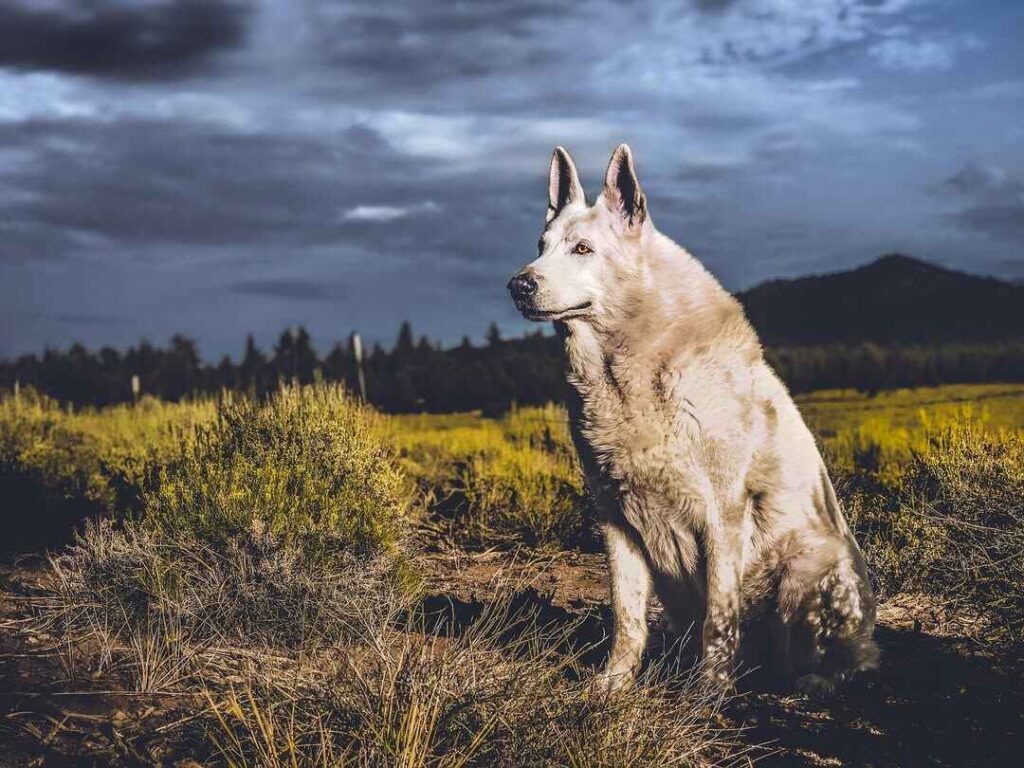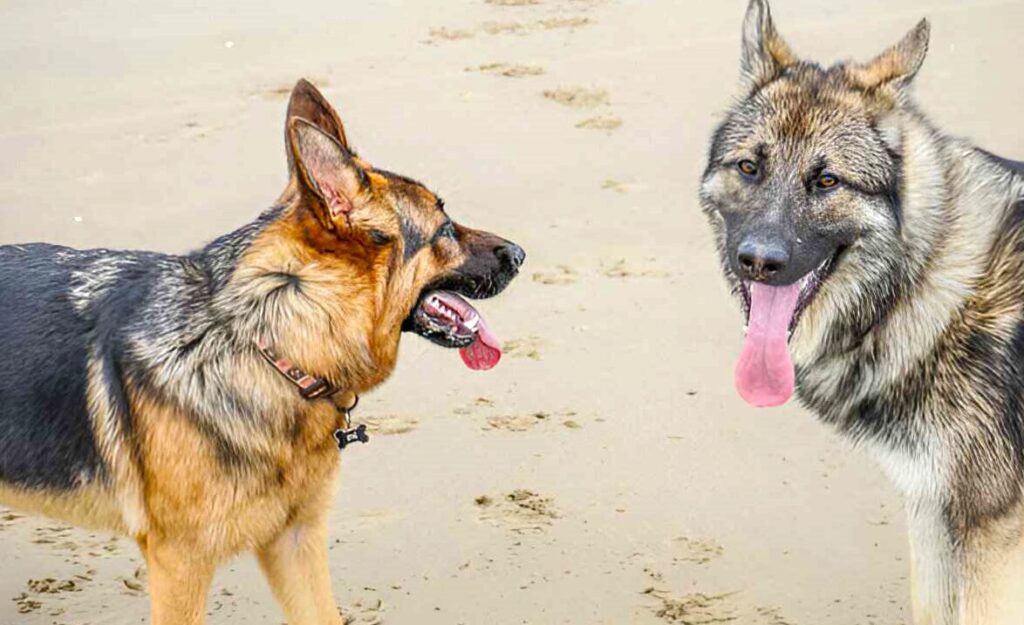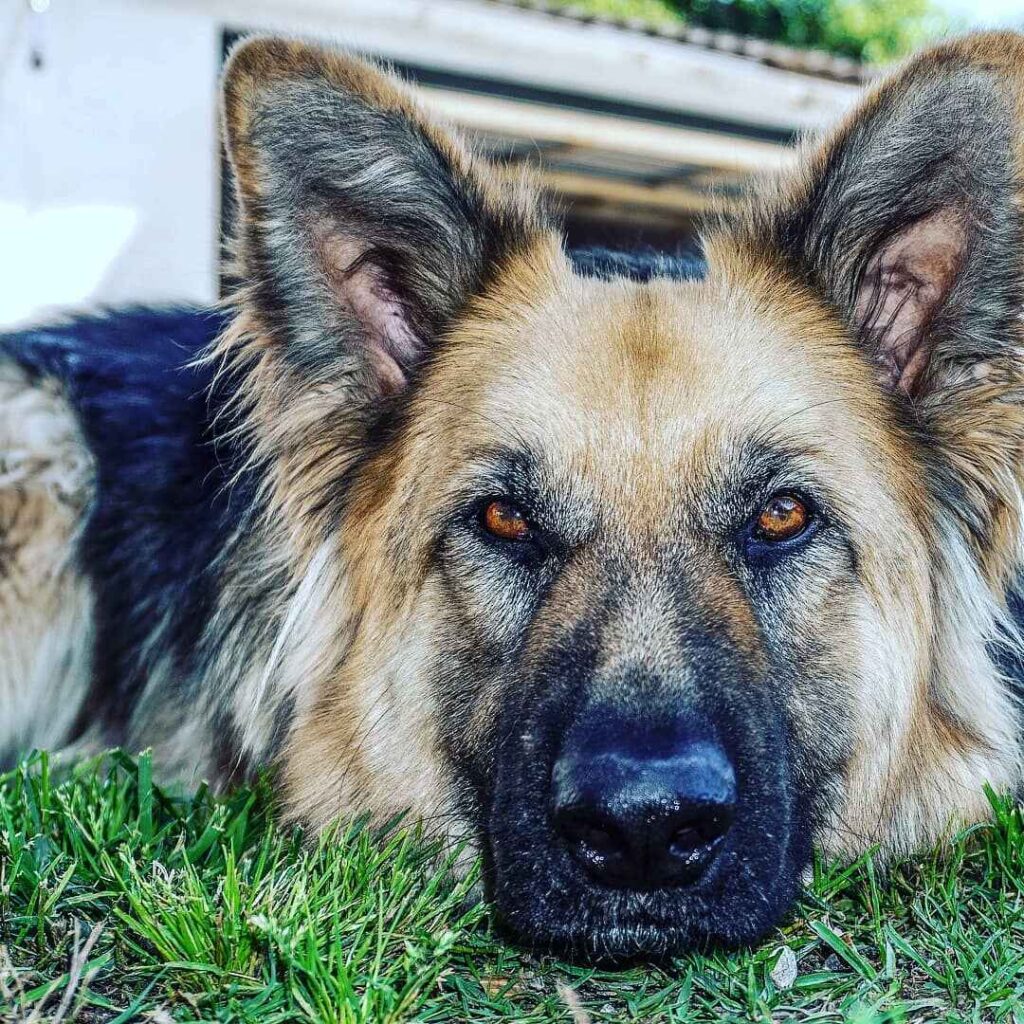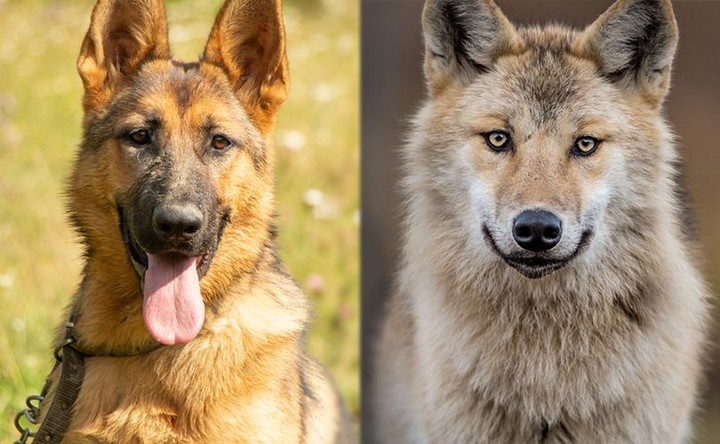The German Shepherd Wolf Mix has a rich history dating back 15,000 years to the first domestication of wolves. These magnificent creatures can weigh between 50 and 120 pounds and grow up to 24 inches tall. Their impressive stature comes with the most important responsibilities.
The wolf shepherd dog stands apart from typical pets. A german shepherd wolf hybrid needs at least 1-2 hours of exercise daily. Many areas enforce strict legal restrictions on ownership. People who are thinking about getting a german shepherd half-wolf or researching wolf german shepherd breeds should know something vital. These animals need complex care and show unpredictable behavior, making them unsuitable for first-time dog owners. This piece explores the detailed information you need before welcoming one of these remarkable creatures into your home.
Understanding the German Shepherd Wolf Mix
A German Shepherd Wolf Mix comes from breeding a German Shepherd with a wolf or another wolfdog. These remarkable creatures show a unique blend of domestic and wild traits that sets them apart from typical companion dogs.
What defines a wolf shepherd dog
We bred wolf-shepherd mixes by pairing a wolfdog with another wolfdog or dog. These animals get traits from both parent species. The result is a distinctive hybrid that combines German Shepherds’ strength and intelligence with certain wolf features.
These hybrids share 99.9% of their DNA with wolves. Pure wolves reach sexual maturity at around 2 years old and have 4-6 puppies each year. German Shepherds can breed twice yearly with a bigger litter of about 8 puppies.
Physical characteristics

(Photo Credit: trigger_t4r|instagram)
Wolf shepherd mixes’ looks vary by a lot based on their genes. These impressive canines usually weigh between 50 to 120 pounds. Their striking features include:
- Dense double-layered coat in shades of sable, white, or black
- Slightly smaller head like in pure wolves
- Almond-shaped eyes ranging from amber to golden
- Large, pointed ears with less fur than pure wolves
On top of that, these hybrids have longer canine teeth than similar-sized dogs. Tests showed their exceptional tracking abilities. They can find targets in 15-20 seconds, while regular police dogs take 3-4 minutes.
Common misconceptions
People have many wrong ideas about these fascinating creatures. German Shepherds’ DNA does not come from wolves. In stark comparison to this, many people think dogs with wolf-like looks are wolfdogs. Experts look at physical and behavioral signs to put them into four simple groups: no-content, low-content, mid-content, and high-content.
There’s another reason why these animals surprise people. Early socialization helps change some behaviors, but their temperament can be unpredictable in new or scary situations. These hybrids often show strong prey drive and territorial instincts that make them a poor fit for homes with smaller pets.
Knowing how to handle these aspects is vital since wolf hybrids just need specialized care. Their unique genetic makeup creates a complex animal that thrives with experienced handling and the right living conditions.
Legal and Ethical Considerations
Legal responsibilities for German Shepherd Wolf Mix owners can be complex and they change a lot depending on where you live. You need to know these rules because they’ll affect whether you can keep these unique pets.
State regulations
Rules for wolf shepherd dogs range from total bans to regulated ownership. Right now, twelve states won’t let you own wolfdogs at all, including Connecticut, Georgia, Hawaii, and New York. States like Arizona, Colorado, and Nevada allow these pets but usually let counties make their own rules.
Some states take a balanced approach with different restrictions:
- Alaska, Delaware, and Michigan need special permits
- California, Colorado, and New Jersey have strict rules about containment and vaccinations
- Montana makes owners get tattoos or microchips for wolfdogs that are 50% or more wolf
Required permits and licenses
Getting the right permits means meeting specific rules that change by location. To name just one example, Pennsylvania requires owners to:
- Show they can provide proper care
- Give detailed parent information
- Prove legal purchase
- Keep rabies shots current
- Follow state dog licensing rules
Rabies vaccinations create a big challenge. Many areas require them, but no vaccine exists specifically for wolf hybrids. So vets often ask owners to sign waivers that acknowledge using regular dog vaccines “off-label”.
Some places treat these animals like dangerous wildlife, so you’ll need permits like those for exotic pets. Florida’s rules say owners need special permits when their wolf shepherd has 75% or more wolf genetics.
Housing rules are strict too. Wisconsin requires enclosed pens that must have:
- At least 300 square feet for up to two wolf hybrids
- 100 more square feet for each extra animal
- 6-foot minimum wall height for covered pens
- 8-foot walls with 3-foot angled tops for open enclosures
Local rules often end up being stricter than state laws. Even if your state allows wolf german shepherds, specific counties might ban them completely. These rules keep changing, which means current owners might face new restrictions or requirements.
Cost of Ownership

(Photo Credit: abbeast44|instagram)
A German Shepherd Wolf Mix needs solid financial planning before you bring one home. You should understand the complete cost breakdown to prepare for this unique commitment.
Initial purchase price
Wolf shepherd dog prices vary based on wolf content percentage and breeder reputation. Low-content wolf shepherds cost between USD 800 to USD 1,000, while high-content varieties can reach USD 3,000. Some breeders sell older dogs at lower prices ranging from USD 350 to USD 500.
Setup expenses
Your wolf german shepherd needs a proper environment that requires a significant upfront investment. A containment system starts at USD 2,000 and must include:
- Eight-foot fences with climb barriers at 40-degree angles
- Underground wire extending 3 feet outward to prevent digging
- Circular cage design to prevent aggressive cornering
- Heated water bowls plus adequate shelter with straw bedding
The first veterinary care package includes vaccinations, microchipping, and spaying or neutering costs between USD 200 to USD 500. Simple supplies like beds, crates, toys, and feeding equipment cost USD 200 to USD 500.
Ongoing monthly costs
A german shepherd wolf hybrid’s monthly expenses range from USD 220 to USD 470. This budget covers:
- Premium quality food: USD 60 to USD 100
- Training sessions: USD 20 to USD 50
- Grooming needs: USD 40 to USD 60
- Pet insurance: USD 30 to USD 70
- Treats plus rewards: USD 25 to USD 40
- Routine veterinary care: USD 50 to USD 70
- Toy replacements: USD 15 to USD 30
Emergency fund needs
Wolf german shepherds’ unique genetic makeup often leads to specialized veterinary care needs. Real cases show owners spending up to USD 10,000 in first-year medical expenses alone.
You should set aside USD 30 to USD 50 monthly for unexpected costs. This fund helps with emergency vet visits that can cost thousands of dollars. Finding boarding facilities is challenging since these hybrids need specialized containment measures that increase costs.
Daily Care Requirements
A German Shepherd Wolf Mix just needs careful attention to its unique dietary, physical, and mental requirements. These extraordinary creatures do better with structured routines that respect both their domestic and wild heritage.
Feeding needs
A wolf shepherd dog runs on a protein-rich diet that matches their ancestral eating patterns. These hybrids must eat twice daily, while puppies need three to four feedings until they reach adulthood. Raw meat serves as the foundation of their diet. They typically need three pounds daily to stay healthy.
Their diet should include:
- Raw chicken, turkey, and beef (avoiding pre-cooked meats)
- Fresh grass and vegetation for digestion
- Supplements like glucosamine, vitamin C, and fish oil
Exercise routine
German shepherd wolf hybrids require substantial physical activity to stay healthy. These energetic animals need about two hours of daily exercise. Their exercise routine should include:
- Long-distance walks or runs
- Swimming sessions (when weather permits)
- Structured play activities
- Mountain biking (during cooler weather)
Mental stimulation
Wolf german shepherds need regular mental challenges to avoid destructive behaviors. Interactive activities boost their cognitive abilities:
- Problem-solving games using treat-dispensing toys
- Scent-based activities
- DIY agility courses
- Hide-and-seek exercises
Grooming schedule
The dense double coat of a german shepherd half-wolf needs consistent care. Brushing should happen every second day to control shedding and prevent matting. These hybrids should never get regular shampoo baths because it ruins their natural protective oils.
Essential grooming practices include:
- Regular ear checks and cleaning
- Monthly nail trimming
- Dental hygiene maintenance
- Seasonal undercoat management during spring and fall shedding periods
Shedding seasons can leave these animals looking almost naked as their fur falls out in clumps. Their coat usually grows back by early September. Some owners might need professional grooming services. Self-service options work better since these hybrids often show challenging behaviors in traditional salon settings.
Training and Socialization

(Photo Credit: SashaFoxWalters|istockphoto)
Training a German Shepherd wolf mix successfully requires understanding their unique psychology and dedicated commitment. These remarkable creatures learn differently from typical dogs and need specialized approaches that respect both their wild and domestic heritage.
Early puppy training
Wolf shepherd dogs’ critical socialization window closes remarkably early, typically around 20 days, unlike domestic dogs’ 4-month window. This brief timeframe makes early intervention vital to develop well-adjusted adults.
Training sessions should be brief yet frequent, lasting 5-10 minutes multiple times daily. The quickest way involves:
- Positive reinforcement exclusively
- Clicker training techniques
- Food-based rewards
- Short, engaging sessions
German Shepherd wolf hybrids with mid to high content need socialization starting at ten days of age, even before their eyes open. These unique creatures need about 2,000 hours of dedicated socialization and handling during their first four months.
Professional training needs
Wolf German Shepherds’ complex nature often requires specialized professional guidance. These animals learn exceptionally well through positive reinforcement methods and often surpass their pure-bred counterparts in learning speed. Their training presents unique challenges.
These hybrids show heightened sensitivity to negative experiences. The whole ordeal might permanently affect their behavior. Professional trainers must have specific expertise in handling wolf-dog hybrids because traditional dog training methods don’t work.
Professional training should focus on:
- Building trust through consistent positive interactions
- Developing reliable recall commands
- Managing resource-guarding tendencies
- Addressing separation anxiety issues
These animals need ongoing daily maintenance of their socialization levels even after their original training. They experience more pronounced fear periods and puberty-related behavioral regressions compared to regular dogs.
Their response to correction is a vital aspect many overlook. Wolf shepherds might retaliate against physical punishment, unlike domestic dogs. Successful training depends on building strong relationships based on mutual respect and trust.
Mental stimulation matters as much as physical exercise. These intelligent creatures excel at problem-solving activities, though their independent nature challenges traditional obedience training approaches. Professional trainers recommend puzzle toys and interactive games in daily routines.
Health and Medical Care
Wolf shepherd dogs need specialized vet care and extra attention to their specific medical needs. These amazing animals face unique health challenges that we must manage proactively.
Common health issues
Wolf german shepherds get health problems from both parent breeds. Hip dysplasia affects about 20.6% of these animals, making it their most common genetic condition. Elbow dysplasia comes next, showing up in 18.8% of cases.
Here are other major health concerns:
- Degenerative myelopathy, which affects 14.1% of the population
- Exocrine pancreatic insufficiency, where two-thirds of cases show up in German Shepherd lineages
- Bloat can turn fatal in just 30-60 minutes without treatment
Preventive care
Good preventive care begins with regular vet check-ups, twice a year ideally. These visits should include:
- Complete blood count and chemistry panel analysis
- Annual heartworm testing
- Stool sample analysis twice yearly
- Dental health evaluations
- Eye examinations to catch cataracts early
Supplements can help – glucosamine helps with arthritis, vitamin C boosts immunity, and fish oil keeps their coat healthy. People who feed raw diets must balance nutrients carefully because wrong ratios can lead to deficiencies.
Finding qualified veterinarians
Getting proper vet care can be tricky for german shepherd wolf hybrid owners. Many vets won’t treat these animals, mostly because of rabies vaccination concerns. Right now, no rabies vaccine has specific approval for wolf hybrids.
You should look for these key things in a vet:
- Experience with wolf-dog hybrids
- Willingness to give off-label vaccinations
- Knowledge of breed-specific health issues
- Emergency care availability
Most wolf german shepherd owners learn that regular vet practices aren’t enough. These animals often need specialized medical care, and emergency bills can hit thousands of dollars. Building a relationship with a qualified vet becomes crucial to handling routine care and unexpected health issues.
Living with a Wolf Hybrid

(Photo Credit: thewolfage |instagram)
Living with a wolf shepherd dog needs careful planning and unwavering dedication. These remarkable animals need specific living arrangements that work with their natural behaviors and instincts.
Home setup requirements
A german shepherd wolf hybrid needs proper living space with enough land away from busy roads and developed areas. One animal requires at least one acre (200′ x 200′) of space. Each additional hybrid needs another half-acre of land.
Essential enclosure specifications include:
- Eight-foot-high chain-link fencing with two-foot extensions
- Buried concrete barriers extending two feet underground
- Double-gate system with secure, lockable latches
- Good drainage and weather-resistant shelters
Safety considerations
Wolf german shepherds show their territorial instincts through marking behaviors that can extend to furniture and living spaces. These animals have amazing physical abilities and can easily climb six-foot fences. Their predatory drive needs careful handling around smaller pets and children.
Key safety measures include:
- Installing electric wires along fence tops
- Keeping secure barriers between living spaces
- Having separate containment areas for emergencies
- Setting clear boundaries between human and animal spaces
Impact on lifestyle
A german shepherd half-wolf will completely change your daily routine. These social creatures need lots of attention and interaction from their human pack members. They react strongly to environmental changes, so living in quiet areas far from neighbors becomes necessary.
Your daily life will change in these ways:
- Spending lots of time as a companion
- Handling their strong territorial behaviors
- Meeting their unique social needs
- Finding specialized care during absences
Most boarding facilities won’t accept wolf german shepherds, which makes travel planning difficult. These animals feel stressed in new environments, making simple tasks like vet visits much harder.
Wolf shepherd dogs naturally howl, so they need to live far from residential areas. Their strong curiosity and desire to explore often lead to many household changes. Even the most social hybrids might act unexpectedly, so you need constant watchfulness and flexibility.
Alternatives to Consider
People who want a wolf’s majestic look without the challenges of owning a hybrid have several great alternatives. These dogs look similar to wolves and have temperaments that work well with families.
Similar-looking dog breeds
Several breeds capture a wolf’s look and personality naturally. The Northern Inuit Dog emerged in the 1980s from a mix of German Shepherd, Siberian Husky, and various Inuit breeds to create a wolf-like appearance. The Czechoslovakian Wolfdog came from breeding German Shepherds with Carpathian wolves in 1955 and shows high intelligence with strong working abilities.
Other notable wolf-like breeds include:
- Tamaskan: A breed created from Huskies, Malamutes, and German Shepherds to look like wolves
- Utonagan: A mix of Alaskan Malamute, German Shepherd, and Siberian Husky genes
- Saarloos Wolfdog: Created in 1935 by crossing German Shepherds with European wolves
Benefits of pure German Shepherds
Pure German Shepherds have many advantages over wolf hybrids. These smart and loyal dogs excel as police partners and family protectors. Their domestic nature helps them bond strongly with one owner while staying affectionate with all family members.
Key advantages of pure German Shepherds include:
Pure German Shepherds adapt well to regular feeding schedules and thrive on commercial dog food made for their specific needs. Their breeding patterns stay consistent, and females usually have about eight puppies in each litter.
These dogs show exceptional smarts and learn commands quickly. Their success in police and military work proves they can handle complex tasks while staying loyal. Families looking for reliable protection without a hybrid’s unpredictable nature often choose German Shepherds.
German Shepherds fit well in different living situations. Though cautious around strangers at first, proper training helps them blend into family life. They protect their home while showing genuine love for the children they grow up with, striking an ideal balance between guardian and friend.
Pure German Shepherds give you the powerful presence and smarts that make wolf hybrids attractive but in an easier-to-handle package. Their proven success as working dogs and ability to form deep emotional bonds make them perfect for anyone drawn to wolf-like traits who wants a more predictable and domestic companion.
Is a German Shepherd Wolf Mix Right for You?
You need to think over your decision carefully before bringing a wolf shepherd dog into your home. These extraordinary creatures need specific conditions and dedication that go beyond what regular pets require.

(Photo Credit: instagram)
Owner requirements
You must have extensive experience with challenging dog breeds to handle these animals. These hybrids aren’t suitable for first-time dog owners because their behavior patterns mirror wild animals more than domestic pets. Even experienced handlers face unique challenges since these animals just need about 2,000 hours of dedicated socialization within their first four months.
Essential owner qualities include:
- Knowing how to provide consistent guidance and structured environments
- Financial stability to cover substantial setup and ongoing costs
- Dedication to extensive daily interaction
- Deep knowledge of both canine and wolf psychology
Beyond simple requirements, you must show patience and adaptability. These hybrids often show shyness at first, which means building trust takes time. Their high prey drive means you must supervise them constantly around smaller animals.
Living situation assessment
Your living environment plays a key role in raising a german shepherd wolf hybrid successfully. These animals thrive only in specific conditions that fit their unique needs and behaviors.
Critical environmental factors cover:
- Property ownership versus renting (most landlords prohibit these hybrids)
- Distance from neighboring homes (because they tend to howl)
- Secure outdoor space of at least one acre
- Local zoning laws and community regulations
These creatures don’t fit well in homes with children under twelve years old. Their lightning-fast reflexes and strong prey drive create risks, especially when you have running or crying children. On top of that, proper containment becomes crucial since these animals can easily climb six-foot fences.
Your daily schedule matters too. Working full-time away from home creates major challenges because these pack-oriented animals need constant companionship. Without enough attention and exercise, they often destroy things and can damage whole pieces of furniture.
Conclusion
German Shepherd Wolf Mixes are remarkable creatures that just need exceptional commitment, resources, and expertise. Research shows their complex needs include specialized containment systems worth thousands of dollars. These animals also require 2,000 hours of early socialization to develop properly.
These majestic animal’ owners should understand their wild and domestic heritage completely. Their care requirements go way beyond the reach and influence of typical pet ownership. They just need acres of secure space, specialized veterinary care, and constant companionship. Potential owners should honestly review if they can provide extensive daily exercise, mental stimulation, and a well-laid-out environment.
Pure German Shepherds or other wolf-like breeds could better match those attracted to the wolf’s majesty. These alternatives are nowhere near as demanding, yet they look similar and have more predictable temperaments.
These German Shepherd Wolf Mixes fascinate many with their striking appearance and unique characteristics. They ended up being best suited for experienced handlers who have appropriate resources, and living situations, and show steadfast dedication to meet their extraordinary needs.
FAQs
Q1. What is the typical lifespan of a German Shepherd Wolf Mix? German Shepherd Wolf Mixes, also known as wolfdogs, typically live between 12-18 years. However, their lifespan can vary depending on factors such as genetics, diet, exercise, and overall care.
Q2. Are German Shepherd Wolf Mixes good family pets?
German Shepherd Wolf Mixes are generally not recommended as family pets, especially for first-time dog owners. They require experienced handling, and extensive socialization, and have complex needs that make them challenging to manage in a typical family setting.
Q3. How much exercise does a German Shepherd Wolf Mix need?
A German Shepherd Wolf Mix requires at least 1-2 hours of daily exercise. This should include physical activities like long walks or runs, as well as mental stimulation through interactive games and training sessions.
Q4. What kind of living space is required for a German Shepherd Wolf Mix?
German Shepherd Wolf Mixes need a secure outdoor enclosure of at least one acre, with 8-foot high fencing and additional safety measures. They also require indoor space, but should not be left unsupervised due to their potential for destructive behavior.
Q5. Are there legal restrictions on owning a German Shepherd Wolf Mix?
Yes, there are often legal restrictions on owning German Shepherd Wolf Mixes. Many states and localities have specific regulations or outright bans on wolfdog ownership. It’s crucial to check local laws and obtain necessary permits before considering this breed.
